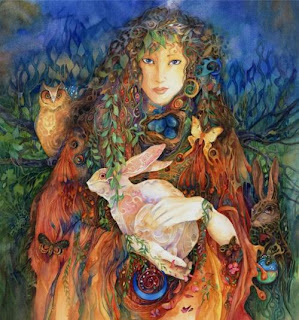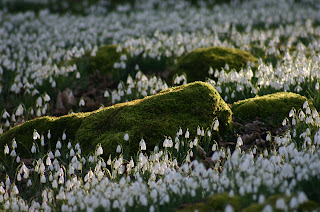Eostre and Ostara
Ēostre and Ostara
Downy yellow chickadee's chirp and peep
Blooms spring forth from budding stems
As sleep is shaken from those hibernating in dens
White, pink, lavender, yellow and peach
The colors of rainbows within our reach!
A swath of your hand and wink from your eye
The hard, dead winter waves it's last good bye.
Awakening, and stretching the inhabitants of the glade
Revel joyfully in your work, your plans well laid.
Beautiful, gracious Eoster, Maiden of Spring
We call to you lady, growth and fertility do you bring!
Equal does time stand, as night gives it's way
Thus the Sun rides high waxing to Solstice Day!
Joyful ! Fulfilled, Spring plants and Vegetables sprout
We thank you Lady for the bounty which will be wrought.
Eoster, Gentle Maiden of Spring
Sunshine, warmth and rain do you bring
Joy, love, life and sustenance to us
Lovely maiden, Spring Noblesse.
~Nyt 01/12
Ostara
March 21st or 22nd Vernal Equinox
Cross Quarter Sabbat
Ēostre or Ostara is a Teutonic Goddess of the Spring. Her rites and festivals were celebrated in what corresponds to the month of April, (referred to as Northumbrian: Ēosturmōnaþ; West Saxon: Ēastermōnaþ; Old High German: Ôstarmânoth) Our only written documentation of Ēostre come from
author Bede, who refers to her in his eight century work "De temporum ratione". He states that her veneration and celebration had long since ceased as of his writing and had been replace by the Paschal Month (celebration of the resurrection of the Christ). There are connections to her and ancient Germanic Easter customs of colored eggs and Hares.
Writing in 1972, John Andrew Boyle cites commentary contained within an etymology dictionary by A. Ernout and A. Meillet, where the authors write that "Little else [...] is known about [Ēostre], but it has been suggested that her lights, as goddess of the dawn, were carried by hares. And she certainly represented spring fecundity, and love and carnal pleasure that leads to fecundity."
So what is Ostara to paganism today?
Ostara is of course the spring celebration of the Goddess Ēostre. Today it is celebrated on the Vernal Equinox. A time when the light and dark are perfectly balanced. The dark however gives way to the light, as the year waxes onward.
Ostara, like the Christian Holiday Easter, (Christianity derives the holiday name from the Teutonic Festivals of Ēostre), is the celebration of rebirth and the renewed life of the earth, brought forth by the spring! Like the spring goddess from which it derives it's name. The symbolism of this rebirth and renewal permeates through nature. The young chicks, lambs and the first birth of the herd animals have come. Those sleepy inhabitants hibernating in their dens , yawn and stretch, rubbing the sleep from their eyes. It seems that the entire earth is waking, to an enchanting morning! The first spring vegetables are poking their heads up from the soft earth. Growth is everywhere!
My fondest memories of this time, come from my childhood in North Carolina, the dogwood blooms covered the trees like snow, the bright azalea's in every hues of pink, white and orange painted a swaths of color across the landscape.
As a celebration of rebirth and renewal, brightly colored and painted eggs, Hares, equilateral crosses, butterflies, chicks are familiar symbols at this time. Brightly colored eggs of course symbolic of fertility and seeds as the holders of life and infinite potential. Hares and Bunnies, of course, unbridled sexuality. If you ever owned a bunny you well understand the idiom, multiplying like rabbits! Butterflies, emerging from their cocoons, transformed, reborn beautifully bright in color. Chicks of course fertility, and new birth, the waxing times of our lives, bright, soft and new!
Important and key concepts to keep in mind for our celebrations! Renewal, Rebirth, Growth, Fertility. Ostara is an excellent time to renew your own vows , or rededicate your self to your path. Many traditions in paganism and witchcraft use Ostara as a time for dedications and initiations.
So what are some fun things you can do to celebrate Ostara?
- Precisely on the Equinox, place and egg, wider end down, on the ground. The egg should balance perfectly.
- Make equilateral crosses to hang around the house.
- Bless seeds for planting. This is a great time to start your spring planting.
- Color eggs, paint pagan symbols on them, bless them. Decorate you altar with them, use them for egg hunts!
- Ham, is traditional for feasting at this time, the last of the cured meats from the winter stock!
- Bright spring flowers, tulips , daffodils, hydrangea, lilacs, are wonderful to fill your home with!
- New clothes! Yes this is where Easter finery comes from. Treat yourself to something bright and hew to lift your spirits and shake off the winter.
One thing interesting to note in traditional observances of Ostara. The God is a young man, just coming towards sexual awakening. He is getting ready for the marriage to come at Beltane with the Goddess.
He is the Green Man, the Oak King/ Sun King. His own seed quickening and readying to fertilize. In many traditions, you have no doubt read, of the fight between the Oak King and the Horned One/ Holly King. Many traditions place these battles, on the Solstices. When the Kings are respectively at the apex of their powers. However, my first High Priestess taught it a different way. We celebrated the battles of the Kings at Ostara and Mabon instead. Light and Dark are equal. The Kings well matched for their fights. The outcome of the battle deciding the turn of wheel of the year. This was always one of the most enjoyable aspects of festivals, so now I pass it on to you.
Correspondences for Ostara:
- Alternative Names/ Celebrations: Spring Equinox, Vernal Equinox, Ostara, Esther, Eostre, Ostarun, startag', Eastre, Eoastrae, Oestre, Lady Day, Alban Eiler (Druidic), Summer Finding (Asatru), Naw Ruz (Persian New Year), Alban Elfed, Festival of Trees, No Ruz, Rites of Spring
- Symbols & Decorations Eggs, rabbits, hares, chicks, sprouting plants, coccons, butterflies, bees, lambs, pussy willows, four leaf clovers, baskets, budding twigs, birds, spring flowers, colorful ribbons
- Dieties: (archetypes) Maiden, young God, Green Man, Oak King, (specifc) Astrarte, Asasa Ya (Ashanti), Aurora, Brigit, Cybele, Ēostre, Eos, Flora, Freya, Persephone (as Kore) ,Ares, Mars, Attis, Adonis, Osiris, Narcissus, Hyacinth and Dionysus, Nayame, Saraswati (Hindu)
- Ritual Work: rebirth, renewal, new beginings, growth, fertility, new life, balance, planting, cultivating, love, health, healing, agriculture, prosperity, purification, dedication, initiation, mysteries
- Colors: red, greens (soft), blue (robins egg) pastels
- Animals: dragons, hares, rabbits, chicks, lambs, butterflies, snakes, robins
- Stones: Carnelian, coral, agate, brown jasper (orange stones), amethyst, aquamarine, bloodstone, red jasper
- Plants: crocus, daffodil, dandelion, forsythia, echinacea, golden seal, hibiscus, honeysuckle, hyacinth, iris, irish moss jasmine, lilly, narcissus, oak, peony, primrose, snowdrop, thistle, tulip, violet., woodruff, all spring flowers
- Incense/Oils: ginger, jasmine, lavender, lotus, magnolia, rose, sage, strawberry, violet,
- Foods: seasonal foods,jelly eggs (jelly beans), edible flowers, fish, chocolates, lamb, eggs, seeds, honey cakes, leafy green vegetables, spiced or flower cupcakes, fruits, hot cross buns, ham, sprouts, honey cakes, unleavened bread, fresh fruit, milk, dairy, nuts, asparagus
I wish you a most enjoyable Ostara and May the Blessings of Spring be yours!



Comments
Post a Comment